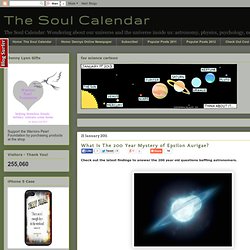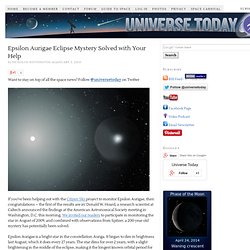

Swallowed by the dragon Smaug. Check out the latest findings to answer the 200 year old questions baffling astronomers.

Artist rendition of Epsilon Aurigae From Denny: For a couple of centuries now astronomers have been baffled by the star Epsilon Aurigae (pronounced EP-si-lon au-RYE-gee). They have been frustrated to discover the reason why the brightness of the star always dims for about a two year period. The star's light fluctuates regularly in a cycle of about 27.1 years. In the winter sky this time of year look up to see Polaris and to the northeast The Big Dipper. Brian Kloppenborg and 16 other astronomers solving the mystery Brian Kloppenborg, an astronomer at Mt. Kloppenborg has published in the science journal "Nature" and excited both amateur and professional astronomers to aid him in his quest.
Just how distant is Epsilon Aurigae? When the astronomy mystery first began How did this fascination with the star's light begin? A swarm of meteorites. A black hole. A large and dusty cloud. In fiction. The most interesting feature, to me, of Poul Anderson's "Kyrie" (Going For Infinity, New York, 2002) is the Aurigean, Lucifer, who sounds exactly like the "Angels", one of them also called Lucifer, in James Blish's The Star Dwellers and Mission To The Heart Stars.

Blish's Angels are described as, or at least compared to, intelligent ball lightning. Anderson suggests that planetary ball lightning might be related to the Aurigeans in the same way that simple organic compounds in a primordial ocean are related to later evolved life. In the gas and energy pervading the multiple star Epsilon Aurigae, magnetohydrodynamics evolved as chemistry did on Earth. Ions, nuclei and force fields formed stable plasma vortices which grew, became complex, metabolized electrons, nucleons and X rays, maintained themselves, reproduced and thought. The description of Lucifer as a multi-colored, twenty-meter-wide, space-faring fireball makes him sound exactly like one of Blish's star-dwelling Angels. Citizen science. Eclipse mystery solved. Want to stay on top of all the space news?

Follow @universetoday on Twitter If you’ve been helping out with the Citizen Sky project to monitor Epsilon Aurigae, then congratulations – the first of the results are in! Donald W. Hoard, a research scientist at Caltech announced the findings at the American Astronomical Society meeting in Washington, D.C. this morning. We invited our readers to participate in monitoring the star in August of 2009, and combined with observations from Spitzer, a 200-year old mystery has potentially been solved.
Epsilon Aurigae is a bright star in the constellation Auriga. What exactly passes in front of the star was a mystery, though it was thought that a large disk of material with two stars orbiting tightly in the center is the cause of the eclipse. “If [Epsilon Aurigae] were an F star, with about 20 times the mass of the Sun…a single B star at the center of the disk doesn’t have enough mass to explain the orbital dynamics,” Hoard said. Painted.